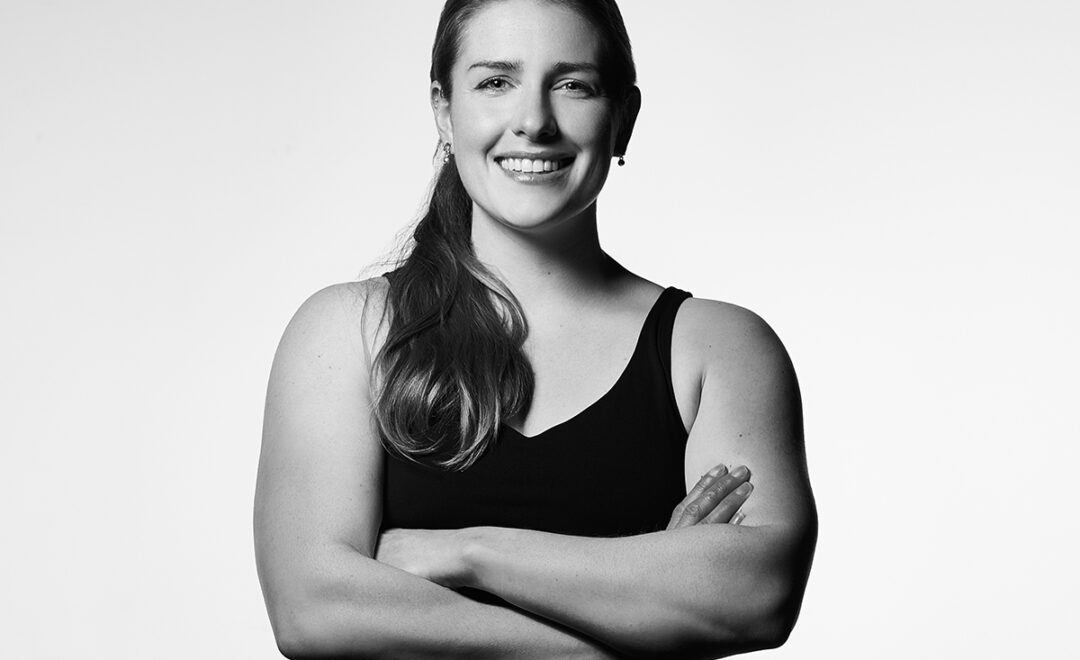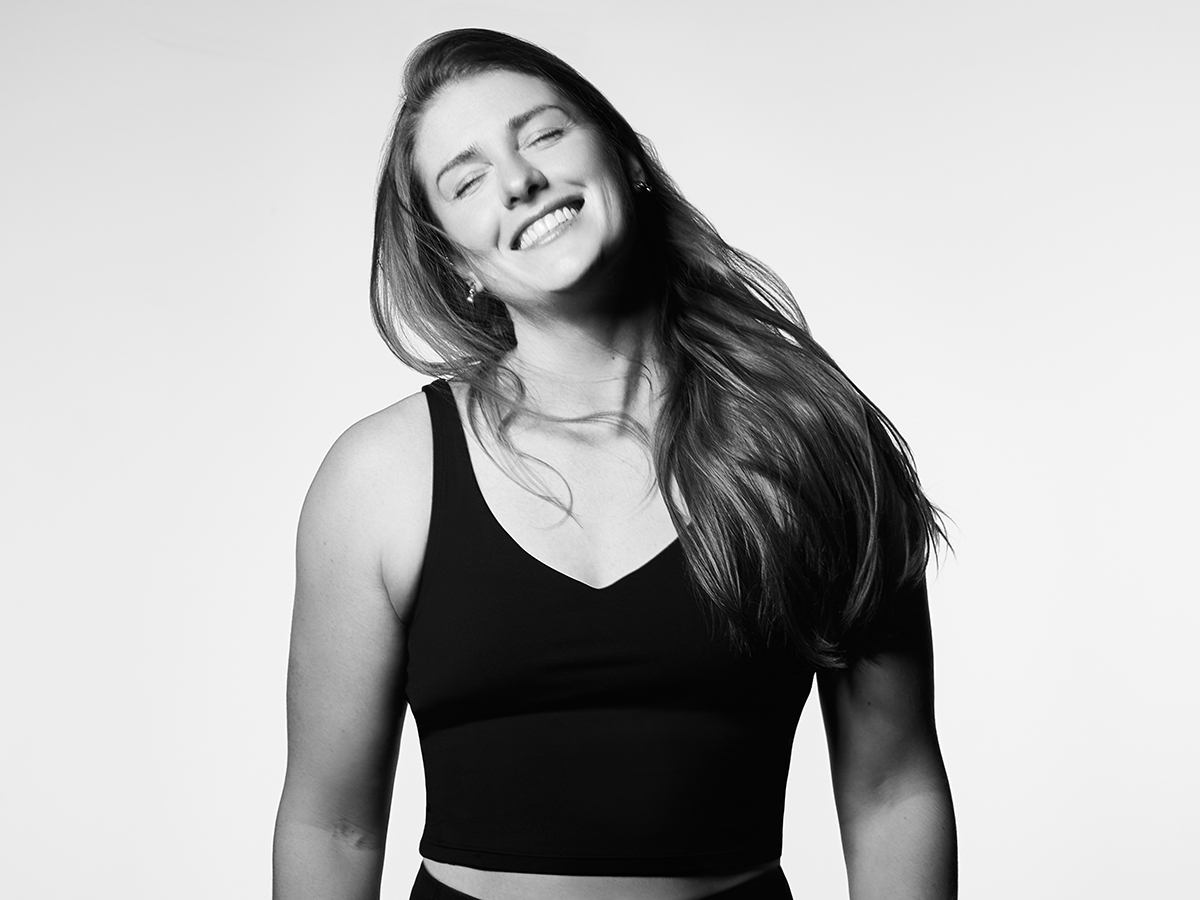Welcome your newest Cut coach, Sarah

As a lifelong athlete, Sarah Cotter understands how exercise can quickly lead to overtraining, overuse, and injury. As someone who sought to strike a healthy balance in her own life, she now encourages athletes to celebrate every milestone—no matter where they’re at in the process.
Off the turf, you can find Sarah reading 100+ books a year, working at a local nonprofit, or volunteering her time at LiveUp, a peer community for adults with down syndrome. Below, she shares her life and career experiences that helped her battle imposter syndrome, take a firm stance against hustle culture, and overcome past fears.
With that, give two claps for your newest Cut coach, Sarah, and look out for her name on the schedule.
How did you enter the fitness community? Were you always an athlete?
I’ve always been an athlete. I’m a former competitive swimmer, and ran throughout high school and into college. When I went through heartbreak or other rough patches, running was always there to get me through it.
In college, running transitioned from something positive into something I could control. I wanted to control how I felt and how I responded to different situations. That quickly manifested into an eating disorder and overtraining, which left me severely underweight.
When I moved to DC post-graduation, I joined the Y and started attending a 30-minute HIIT class. That workout was the first time I picked up a weight. Soon, I shifted my mindset from “How little can I be? How can I take up less space?” to, “How much space can I take up within this class?” Soon after, I started coaching that class as a way to help others facing similar challenges.
How has your experience with overtraining impacted you as a coach?
I love helping athletes pursue a healthy balance—both in and outside the gym.
I’m not a believer in hustle culture. Hustle culture teaches us that if we’re not constantly working toward that next step, we’re settling. As someone who struggled hard to find moderation and satisfaction in my own life, I find this to be a very dangerous mindset.
I want to help clients find a healthy balance between advancing toward that next step, while being happy with where you are. I want you to celebrate the progress you’re in right now. I want you to see a finish line, then break those big hurdles into smaller, more attainable steps—celebrating each and every milestone.
How do you balance your anti-hustle culture while encouraging athletes to reach the next level?

There are plenty of ways to go about that. Cut Seven allows you to step away from yourself, placing the emphasis on cheering on your teammates. The team atmosphere takes the pressure off of you and what you’re doing. Instead, you can make it more about, “How do I make sure my teammate gets through this?”
You don’t need to push yourself to the limit every day. Each of us needs to find space to stop, reflect, and recognize our progress in class. If you just did your first full pushup in class, I want you to be happy with that—while still being hungry for more. It’s our responsibility as coaches to remind athletes of their progress.
How did you find Cut Seven?
I’ll admit: My first class at Cut was a little overwhelming.
It wasn’t because of the workout—it was more, “Wow, everyone knows each other by name and cheers for one another.” I didn’t want to feel like an outsider or an imposter. But the great thing about Cut is that you have those feelings for the first five minutes of class. After that, someone comes over, introduces themselves, and makes you part of the team. I love Cut because you get to share this experience with teammates who become your close friends.
The workout itself was unlike anything I ever experienced, with exercises I never anticipated my body doing. I love how I can become a little less terrified each class, yet still get butterflies before Heart Day. Sometimes, a coach might demo a movement where you think, “I’m not sure if I can physically do that,” then you end up surprising yourself. It’s a good reminder that our bodies move in a lot of different ways.
Where can people find you when you’re not coaching class?
I work with an organization called Spirit Club, which offers fitness programs to adults with physical or mental disabilities. I train people with down syndrome, autism, and cerebral palsy, who might be nonverbal, have balance issues, or struggle with communication.
It’s such a different vibe. Things that we, as athletes, can do easily (like squats) many people can’t. We provide these young adults with independent living skills, range of motion cues, and balance challenges. It’s great witnessing someone progress toward doing things independently.
I spend my weekends volunteering with an organization called LiveUp, a community for young adults with down syndrome. While other organizations, like Best Buddies, offer peer experiences for teenagers, those programs stop once the individual reaches 22. We’re trying to fill that gap as the individual reaches adulthood.
At LiveUp, we take our down syndrome peers on weekend experiences. We work on independent living skills, like brushing your teeth, packing lunches, and practicing healthy hygiene. It’s an opportunity for us, as mentors, to learn to live and integrate with the down syndrome community, while our mentees get the opportunity to hang out with a friend.
How have these two organizations changed your mindset as a coach?
As a coach entering the Cut community, it’s easy to have imposter syndrome. I think about the classes I’ve taken with the other coaches and how they’ve inspired me, and wonder whether I can deliver that same experience.
At LiveUp, I have this mentee named Stephanie who struggles with balance, is nonverbal, and doesn’t understand temperature. For our weekend getaway, she was terrified to take a shower by herself because she doesn’t know whether the water is hot or cold, and she worries whether she’ll slip in the tub.
Think about that! There are so many things—like taking a shower—that we take for granted or don’t think about, yet remain extremely scary for other people. So when I walk into a new environment [like coaching at Cut] and get those feelings of imposter syndrome, I tell myself, “I have no reason not to overcome my fears, if she can overcome hers.”
What can athletes expect from your classes?
I found aspects of Cut I really love. I love making people feel included. I love that athletes can be honest with me when they don’t feel confident. I love working out a plan to help them overcome those fears or insecurities.
At face value, yes—Cut can be intimidating. You’re jumping over hurdles, bear crawling across the turf, or pulling someone with a band. I want to find ways to make the uncomfortable, comfortable—to help you work through those fears. I’ve worked with a lot of people who have hesitations surrounding exercise, and we always find ways to work through it.
I may not be super eloquent with motivational speeches, but I’m transparent. If I think you’re bullshitting yourself on something, you’ll know. I hope athletes know they can be transparent with me as well.
5 fun facts about Sarah
- Her favorite food, hands down, is watermelon—to the point where it’s evolved into part of her personality. Every gift she receives is watermelon patterned.
- She worked at Chuck E. Cheese for six years.
- She hates all scary movies, and confesses to screaming during Ratatouille.
- She reads over 100 books every year. (Favorite book of all time = East of Eden.)
- She has had a pen pal since 2011. The first time they ever met in person is when Sarah was a bridesmaid in her wedding.